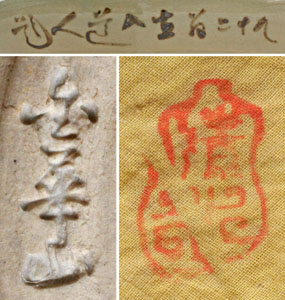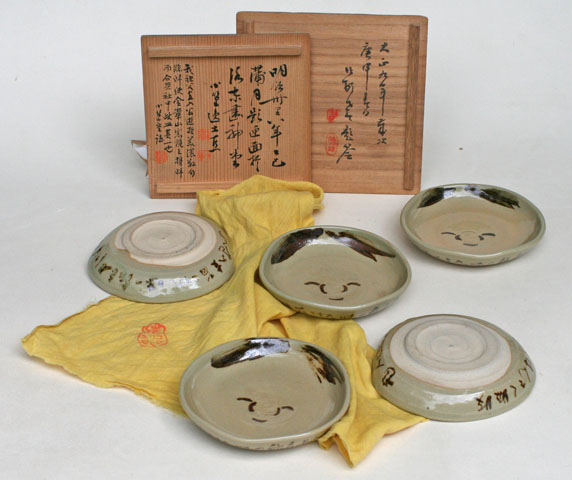Minoyaki
Set of 5 Otafuku dishesSigned: Kyujûniô (92) Chokunyû dôjin dai
Seals: Kinkazan
Technique: grey Minoyaki with tetsu-e underglaze painting and calligraphy Ø 12 x 2.5
Date: 1904
Box: double box authorised in 1905 (Meiji 38) by his grandson Tanomura Shôkô (1878-1910) and on a spring day in 1921 by Tachika Chikuson (1864-1922)
The inscription reads: 妓ふくさんはすかし飩☐の味, ”Fuku the jolly girl shines through while tasting [the snacks].
Shôkô wrote on the box: ”My grandfather, the old Chokunyû, enjoyed a few weeks in Mino. By the time he had to go back he had the Kinkazan kiln to fire a few items. These dishes are a part of which he brought to his society.”
Chokunyû was born in Ôita Takeda in Bungo province. His master Tanomura Chikuden (1777-1835) came from the same area. Chokunyû became his pupil when he was in his 9th year. Chikuden recognized his talents and adopted him, upon which Chokunyû gave up his own family name of Mitsumiya. Apart from his painting activities he also immersed himself in Chinese studies. He was, moreover, a pivotal figure in sencha-loving circles in Kyoto and Osaka. As the number of devotees augmented, he founded a sencha society in Osaka in order to preserve and consolidate the work of earlier sencha enthusiasts like Rai San’yô (1781-1832). It became known as the Seiwan Chakai, Blue Bay Tea Society. As its originator and promoter Chokunyû achieved tremendous fame. Early in the Meiji era he became involved in the founding of Kyoto’s Prefectural Art School and in due course became its first director. He also helped to establish the Japanese Nanga Society. He was a prolific artist not only drawn to landscape and flowers, trees and grasses, but also to birds, animals and human figures. With Tomioka Tessai (1836-1924) he was a leading figure in the sencha world of the Meiji era.
Reference:
Roberts p. 174
Araki pp. 1080-1081
Graham p. 171 ff.
Berry & Morioka ‘99 p. 92-95 (# 12)
Berry & Morioka ‘08 p. 303-05 (# 42-43, 79)
The Kinkazan kiln is located in Mino, Gifu province
Price: ON REQUEST

